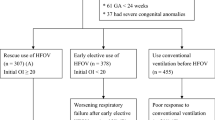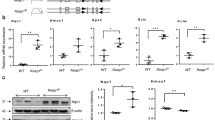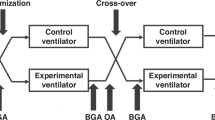Abstract
Exposure to sustained hypoxia (SH) differentially modifies the hypoxic ventilatory response (HVR) in adults and developing rats. We examined the possibility that postnatal intermittent hypoxia (IH), a more prevalent clinical condition than SH, may lead to significant modifications of ventilatory patterning during development. Sprague-Dawley rat pups were exposed as of the d 1 of life to either SH (10% O2) or IH [alternating room air (RA) and 10% O2 every 90 s] for up to 30 d; controls were exposed to normoxia. HVR (10% O2 for 20 min) was assessed in unrestrained pups at 5, 10, 15, and 30 d of age using whole-body plethysmography. IH pups displayed higher normoxic ventilation (VE) at all ages (p < 0.001 versus control; n = 12 per group), which was not observed in SH animals until 10 d of exposure (p < 0.001 versus control; n = 12 per group). Furthermore, both SH and IH modified properties of peak HVR (pHVR), as well as those of the ensuing hypoxic ventilatory decline (HVD); however, the ventilatory strategies adopted after SH and IH greatly differed. We conclude that both postnatal IH and SH modify normal ventilatory patterning and induce altered HVR, but differ in the ventilatory strategies adopted to mount HVR responses.
Similar content being viewed by others
Log in or create a free account to read this content
Gain free access to this article, as well as selected content from this journal and more on nature.com
or
Abbreviations
- HVD:
-
hypoxic ventilatory depression
- HVR:
-
hypoxic ventilatory response
- IH:
-
intermittent hypoxia
- nTS:
-
nucleus tractus solitarii
- pHVR:
-
peak hypoxic ventilatory response
- SH:
-
sustained hypoxia
- VAH:
-
ventilatory acclimatization to hypoxia
- VAIH:
-
ventilatory adaptation to intermittent hypoxia
References
Powell FL, Milsom WK, Mitchell GS 1998 Time domains of the hypoxic ventilatory response. Respir Physiol 112: 123–134
Lin J, Suguihara C, Huang J, Hehre D, Devia C, Bancalari E 1996 Effect of N-methyl-D-aspartate-receptor blockade on hypoxic ventilatory response in unanesthetized piglets. J Appl Physiol 80: 1759–1763
Mizusawa A, Ogawa H, Kikuchi Y, Hida W, Kurosawa H, Okabe S, Takishima T, Shirato K 1994 In vivo release of glutamate in nucleus tractus solitarii of the rat during hypoxia. J Physiol 478: 55–66
Soto-Arape I, Burton MD, Kazemi H 1995 Central amino acid neurotransmitters and the hypoxic ventilatory response. Am J Respir Crit Care Med 151: 1113–1120
Ohtake PJ, Torres JE, Gozal YM, Graff GR, Gozal D 1998 NMDA receptors mediate peripheral chemoreceptor afferent input in the conscious rat. J Appl Physiol 84: 853–861
Aaron EA, Powell FL 1993 Effect of chronic hypoxia on hypoxic ventilatory response in awake rats. J Appl Physiol 74: 1635–1640
Mortola JP, Morgan CA, Virgona V 1986 Respiratory adaptation to chronic hypoxia in newborn rats. J Appl Physiol 61: 1329–1336
Eden GJ, Hanson MA 1987 Effects of chronic hypoxia from birth on the ventilatory response to acute hypoxia in the newborn rat. J Physiol 392: 11–19
Peyronnet J, Dalmaz Y, Ehrstrom M, Mamet J, Roux JC, Pequignot JM, Thoren HP, Lagercrantz H 2002 Long-lasting adverse effects of prenatal hypoxia on developing autonomic nervous system and cardiovascular parameters in rats. Pflugers Arch 443: 858–865
Peyronnet J, Roux JC, Geloen A, Tang LQ, Pequignot JM, Lagercrantz H, Dalmaz Y 2000 Prenatal hypoxia impairs the postnatal development of neural and functional chemoafferent pathway in rat. J Physiol 524: 525–537
Sladek M, Parker RA, Grogaard JB, Sundell HW 1993 Long-lasting effect of prolonged hypoxemia after birth on the immediate ventilatory response to changes in arterial partial pressure of oxygen in young lambs. Pediatr Res 34: 821–828
Jackson A, Nurse C 1995 Plasticity in cultured carotid body chemoreceptors: environmental modulation of GAP-43 and neurofilament. J Neurobiol 26: 485–496
Sterni LM, Bamford OS, Wasicko MJ, Carroll JL 1999 Chronic hypoxia abolished the postnatal increase in carotid body type I cell sensitivity to hypoxia. Am J Physiol 277: L645–L652
Bavis RW, Olson EB Jr, Vidruk EH, Fuller DD, Mitchell GS 2004 Developmental plasticity of the hypoxic ventilatory response in rats induced by neonatal hypoxia. J Physiol 557: 645–660
Jones KL, Krous HF, Nadeau J, Blackbourne B, Zielke HR, Gozal D 2003 Vascular endothelial growth factor in the cerebrospinal fluid of infants who died of sudden infant death syndrome: evidence for antecedent hypoxia. Pediatrics 111: 358–363
Gozal D, Lipton AJ, Jones KL 2002 Circulating vascular endothelial growth factor levels in patients with obstructive sleep apnea. Sleep 25: 59–65
Reeves SR, Gozal E, Guo SZ, Sachleben LR Jr, Brittian KR, Lipton AJ, Gozal D 2003 Effect of long-term intermittent and sustained hypoxia on hypoxic ventilatory and metabolic responses in the adult rat. J Appl Physiol 95: 1767–1774
Gozal D, Reeves SR, Row BW, Neville JJ, Guo SZ, Lipton AJ 2003 Respiratory effects of gestational intermittent hypoxia in the developing rat. Am J Respir Crit Care Med 167: 1540–1547
Reeves SR, Gozal D 2005 Changes in ventilatory adaptations associated with long-term intermittent hypoxia across the age spectrum in the rat. Respir Physiol Neurobiol
Reeves SR, Gozal D 2006 Changes in ventilatory adaptations associated with long-term intermittent hypoxia across the age spectrum in the rat. Respir Physiol Neurobiol 150: 135–143
Dwinell MR, Powell FL 1999 Chronic hypoxia enhances the phrenic nerve response to arterial chemoreceptor stimulation in anesthetized rats. J Appl Physiol 87: 817–823
Gamboa A, Leon-Velarde F, Rivera-Ch M, Palacios JA, Pragnell TR, O'Connor DF, Robbins PA 2003 Selected contribution: acute and sustained ventilatory responses to hypoxia in high-altitude natives living at sea level. J Appl Physiol 94: 1255–1262
Leon-Velarde F, Gamboa A, Rivera-Ch M, Palacios JA, Robbins PA 2003 Selected contribution: peripheral chemoreflex function in high-altitude natives and patients with chronic mountain sickness. J Appl Physiol 94: 1269–1278
Alea OA, Czapla MA, Lasky JA, Simakajornboon N, Gozal E, Gozal D 2000 PDGF-beta receptor expression and ventilatory acclimatization to hypoxia in the rat. Am J Physiol Regul Integr Comp Physiol 279: R1625–R1633
Frappell PB, Mortola JP 1994 Hamsters vs. rats: metabolic and ventilatory response to development in chronic hypoxia. J Appl Physiol 77: 2748–2752
Trippenbach T 1994 Ventilatory and metabolic effects of repeated hypoxia in conscious newborn rabbits. Am J Physiol 266: R1584–R1590
Peng YJ, Rennison J, Prabhakar NR 2004 Intermittent hypoxia augments carotid body and ventilatory response to hypoxia in neonatal rat pups. J Appl Physiol 97: 2020–2025
Waters KA, Laferriere A, Paquette J, Goodyer C, Moss IR 1997 Curtailed respiration by repeated vs. isolated hypoxia in maturing piglets is unrelated to NTS ME or SP levels. J Appl Physiol 83: 522–529
Waters KA, Tinworth KD 2001 Depression of ventilatory responses after daily, cyclic hypercapnic hypoxia in piglets. J Appl Physiol 90: 1065–1073
Wickstrom HR, Berner J, Holgert H, Hokfelt T, Lagercrantz H 2004 Hypoxic response in newborn rat is attenuated by neurokinin-1 receptor blockade. Respir Physiol Neurobiol 140: 19–31
Gozal D, Gozal E 1999 Episodic hypoxia enhances late hypoxic ventilation in developing rat: putative role of neuronal NO synthase. Am J Physiol 276: R17–R22
Peng YJ, Prabhakar NR 2004 Effect of two paradigms of chronic intermittent hypoxia on carotid body sensory activity. J Appl Physiol 96: 1236–1242
Waters KA, Gozal D 2003 Responses to hypoxia during early development. Respir Physiol Neurobiol 136: 115–129
McGuire M, Zhang Y, White DP, Ling L 2002 Effect of hypoxic episode number and severity on ventilatory long-term facilitation in awake rats. J Appl Physiol 93: 2155–2161
Reeves SR, Guo SZ, Brittian KR, Row BW, Gozal D 2006 Anatomical changes in selected cardio-respiratory brainstem nuclei following early postnatal chronic intermittent hypoxia. Neurosci Lett 402: 233–237
Author information
Authors and Affiliations
Corresponding author
Additional information
This study was supported by National Institutes of Health grant HL69932, The Children's Foundation Endowment for Sleep and Neurobiology Research, and by the Commonwealth of Kentucky Challenge for Excellence Trust Fund. S.R.R. is the recipient of predoctoral fellowships from the Ohio Valley Chapter of the American Heart Association and National Institutes of Health (F30 NS-48770).
Rights and permissions
About this article
Cite this article
Reeves, S., Gozal, D. Respiratory and Metabolic Responses to Early Postnatal Chronic Intermittent Hypoxia and Sustained Hypoxia in the Developing Rat. Pediatr Res 60, 680–686 (2006). https://doi.org/10.1203/01.pdr.0000246073.95911.18
Received:
Accepted:
Issue date:
DOI: https://doi.org/10.1203/01.pdr.0000246073.95911.18



